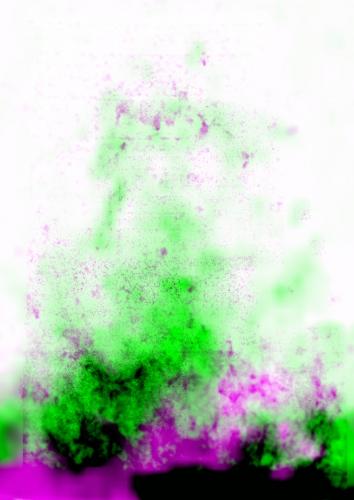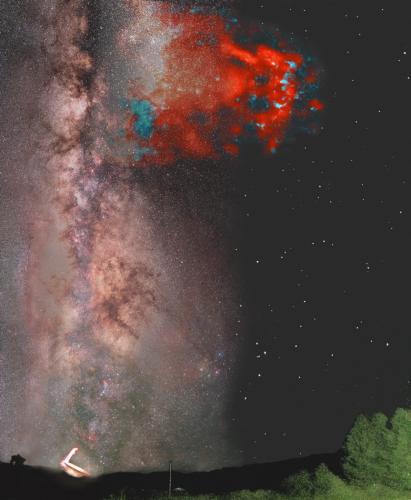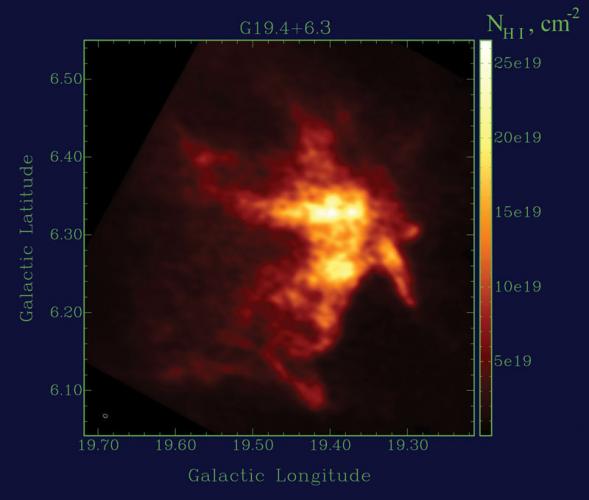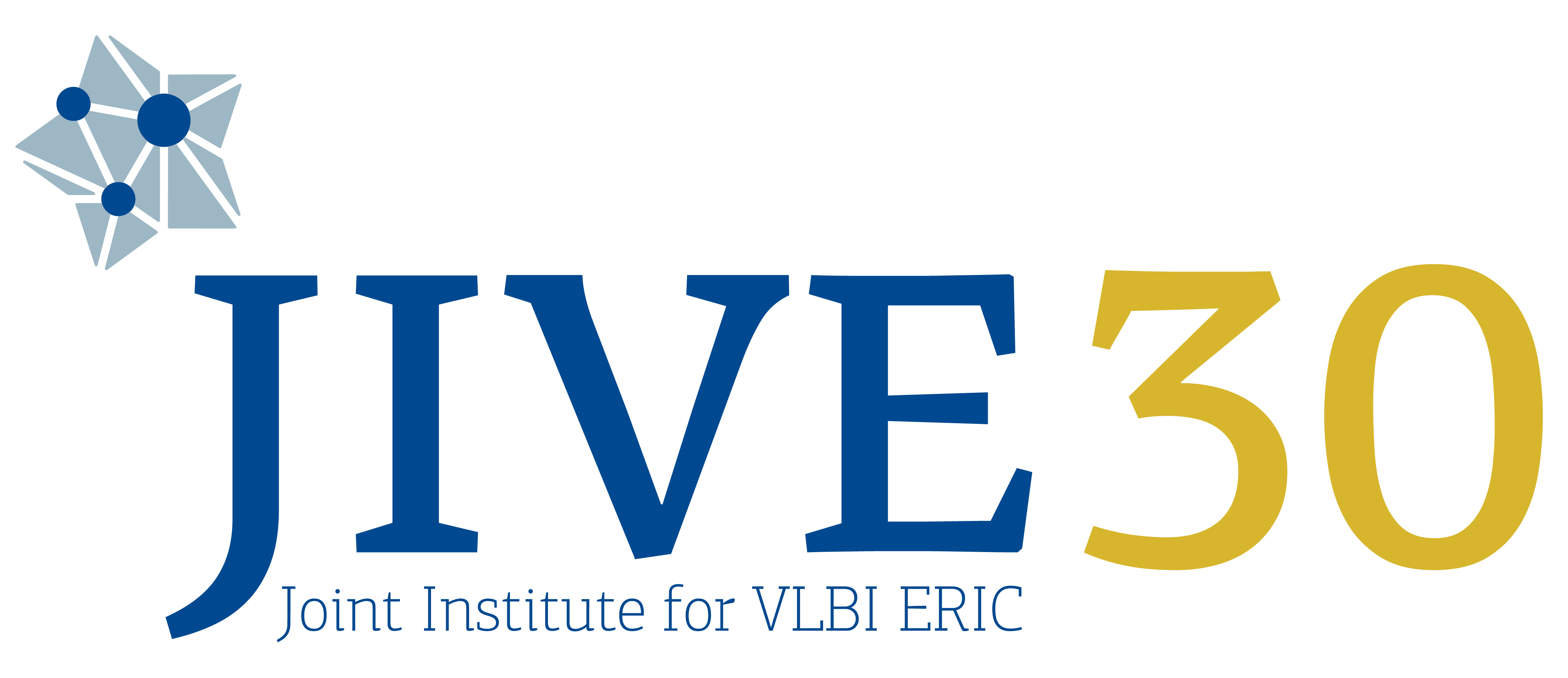Research into Galactic interstellar matter at JIVE is primarily through a large project to study the extra-planar hydrogen in the inner Milky Way, based on the observations of 21 cm HI line with the Green Bank Telescope (GBT), the Very Large Array (VLA) and the Giant Metrewave Radio Telescope (GMRT) in 2003-2007. The project is done in collaboration with Felix Lockman (NRAO) and, in parts, with K.S. Dwarakanath (RRI), Harvey Liszt (NRAO), Joseph Shields (Ohio University) and Michael Rupen (NRAO).
There are two main directions of this research. One is a study of large-scale structures in the Galactic disk-halo interface, the most spectacular of which is the Ophiuchus superbubble, recently discovered in the course of this project. The other is an effort to make high-resolution maps of a chosen number of bright halo clouds. These clouds can serve as probes that provide a lot of information about the physical conditions in the halo.
The VLA observations in D, and in some cases also in C and B configurations provide high angular resolution view of the clouds and GBT data supply short spacing information, to detect extended, low surface brightness emission which might not have been detected by the VLA observations. Using previously developed successful interferometric-single dish data reduction recipes (involving procedures of both AIPS and MIRIAD packages) the maps for a number of clouds were made, including maps of two clouds (G19.4+6.3 and G27.0+6.3) observed in both D and C VLA configurations. A preliminary analysis of these maps gives a strong experimental support to hypotheses about formation of halo clouds due to superbubble envelope disintegration and of their fundamentally unstable nature.
Image 1 (courtesy of NRAO/AUI and Yurii Pidopryhora): The Ophiuchus superbubble recently discovered with the 100 m Green Bank Telescope (GBT) is shown as a false-color image. Purple color is neutral hydrogen detected by its 21 cm radio emission, green -- ionized hydrogen detected by its optical emission, black -- where there are matching amounts of both neutral and ionized hydrogen. The diagonal purple stripe at the bottom results from a stretch of cosmic dust known as the Great Rift of the Milky Way, blocking all the light behind it including the superbubble's ionized hydrogen emission, while the radio emission is not hindered by dust. Such superbubbles are known to be blown by powerful stellar winds and supernovae occuring in star clusters in arms of both our and other spiral galaxies. It took approximately 30 million years and the energy of about 100 supernovae to create this one, which is more than 3 kpc high and is located about 7 kpc from the Sun and 4 kpc from the Galactic center. It is currently at the latest stages of its development, its expansion is stopped and its walls are starting to decompose.

Image 2 (courtesy of NRAO/AUI and Yurii Pidopryhora): The Ophiuchus superbubble is shown as if we were able to see it with the naked eye in the night sky. A picture of the night sky taken from the NRAO Green Bank observatory site is overlaid by an optical image of the Milky Way and a false color image of the superbubble. All angular sizes and relative positions of the objects are real, bright stars were used to match the images together. In the bubble, blue color is neutral hydrogen detected by its 21 cm radio emission, red -- ionized hydrogen detected by its optical emission, white -- where there are matching amounts of both neutral and ionized hydrogen. On the left side of the horizon we see a silhouette of the 140-foot telescope and the brightly lit GBT. The part of the Milky Way shown in the image is about 1/6 of its total circumference. The area of it close to the GBT is the Galactic center. The wide dark lane sweeping across the lower side of the bubble is known as the Great Rift -- a stretch of cosmic dust blocking all the light behind it including some of the superbubble's ionized hydrogen emission -- that is why we see a blue patch there. Above the right side of the horizon we see an arc of 5 stars -- part of Corona Australis constellation, above it -- the "head" and "pincers" of Scorpius, and still higher the base of Ophiuchus, the constellation in which most of the superbubble is located. If one wants to locate the superbubble's position in the sky, she/he should look for the Bull of Poniatowski asterism marking the very middle of the bubble. However even if our eyes were able to see 21 cm radio emission and were sensitive enough for the ionized hydrogen line, we still would not see this superbubble because it is hidden behind much brighter emission of closer Galactic gas. Only specially designed experiments with state-of-the-art astronomical equipment have allowed us to discover it.
 Image 3: Total HI column density map of halo cloud G19.4+6.3, one of the maps produced by combining observations of the VLA in D and C configurations and the GBT. The map shown is integrated over 48 spectral channels of 0.64 km/s width, rms noise is 8.7×1018 cm-2, synthesized beam FWHM 32.5"x25.6", which at the estimated distance of 8.0 kpc is equivalent to the linear resolution of 1.12 pc (the beam is shown in the bottom-left corner). This map was produced using the resulting AIPS VTESS model of the signal.
Image 3: Total HI column density map of halo cloud G19.4+6.3, one of the maps produced by combining observations of the VLA in D and C configurations and the GBT. The map shown is integrated over 48 spectral channels of 0.64 km/s width, rms noise is 8.7×1018 cm-2, synthesized beam FWHM 32.5"x25.6", which at the estimated distance of 8.0 kpc is equivalent to the linear resolution of 1.12 pc (the beam is shown in the bottom-left corner). This map was produced using the resulting AIPS VTESS model of the signal.
Contact
Questions about molecular gas research at JIVE should be directed to Yurii Pidopryhora.
